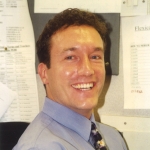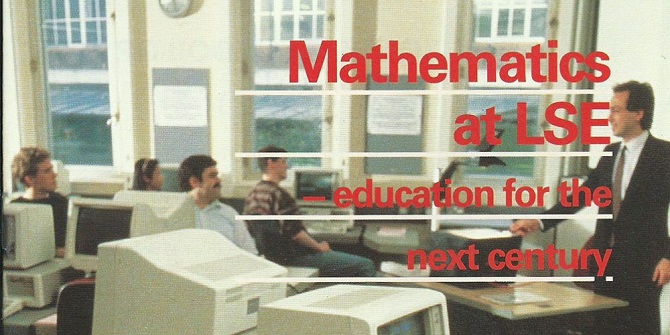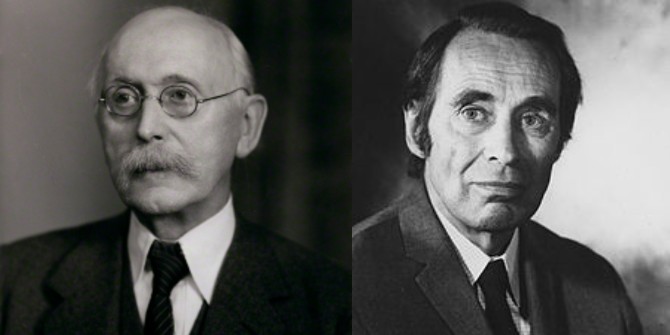Previous instalments of this brief history have described how LSE recruited a group of mathematicians in 1966 and set up a small Department of Mathematics in 1994. In this final instalment, Norman Biggs concludes his brief history of mathematics at LSE.
At the start of the 1998/99 session the Department was still small, but hopeful. The Department was “research-active”, the degree in Mathematics and Economics was attracting many excellent students, and a good range of mathematical topics was being taught. The regular seminars were well-attended, the highlight being a talk by the leading graph-theorist W T Tutte in June 1997, when the significance of his secret work as a code-breaker in World War 2 was just being revealed to the public.
Bill Tutte is pictured here in front of a replica of the world’s first electronic computer, COLOSSUS. The original was built in 1944 to perform code-breaking calculations based on his work at Bletchley Park.
However, the future was by no means certain. The Department was soon to undergo no less than three assessments of its performance, and all of them had to be taken seriously. The first hurdle, a review by the Academic Planning and Resources Committee (APRC) was scheduled for November 1998. As part of our preparations the proposal for new degree programme in Mathematics and Finance seemed to be both timely and feasible, since a third-year course in the Mathematics of Finance and Valuation had been running for several years, taught by Adam Ostaszewski. Sadly, this proposal was blocked by other interested departments. We proposed some other initiatives, but the APRC was lukewarm about our prospects. Resources sufficient to maintain our current level of activity were provided, accompanied by a suggestion that we might merge with another (unspecified) department. Subsequently a minor improvement in resources was agreed, but there was no encouragement to think ahead.
One forward step did take place, despite the gloom. For a couple of years after the Department’s formation the office work had been shared with Statistics, but by the end of 1996 we had our own administrator. LSE’s rules on the grading of support staff were changing, and this resulted in the appointment of David Scott in March 1999.
Soon afterwards the sterling work of Jackie Everid was recognised by promotion and the title of Undergraduate Course Coordinator. For many years, David and Jackie were destined to spend their days coping with the strange ways of mathematicians, both staff and students. David is pictured here after his appointment in 1999. He remained with the Department until 2015.
The difficulties with the APRC did not bode well for the two external reviews that were looming: teaching was to be assessed by the Quality Assurance Agency (QAA), and research by a Research Assessment Exercise (RAE). The QAA process was new. All university departments were to be visited by panels who would base their findings on documentary evidence. The visits were to be done in batches, by subject, and Mathematical Sciences was one of the first. Our visit was scheduled for November 1999, and would be joint with the Department of Statistics. The mathematical community as a whole was taking this operation seriously, and there was a distinct possibility that we should be made to appear amateurish in comparison with universities that had taken steps to sort out their processes and their paperwork. One worrying problem was that some of the School’s procedures, particularly with regard to examinations, were not in tune with those in other UK mathematics departments. The Department arranged for a friendly dummy run by Professor Peter Rowlinson, who had already experienced a QAA visit at his own university, and in the end, with the help of hard work by the departmental staff, and a sympathetic review panel, we managed to get a respectable rating, but it was a close call.
LSE was by now aware of the importance of the RAE, although that created another set of problems for Mathematics and other small departments. There was much discussion about the format of LSE submission, which gradually descended into a cosmetic exercise, attempting to construct impressive-looking groups of people to fit the official Units of Assessment. After many months of uncertainty it was decided that the members of the Mathematics Department would be dispersed. Some were to be “Statistics”, some “Business and Management”, and some “Accounting and Finance”. One member of the Department could not be fitted into these categories and reluctantly agreed to become temporarily invisible, after receiving assurances that this was just a convenient fiction. As a result of these tactics the outcome of the RAE was satisfactory for LSE as a whole – but the suggestion that we should merge with another LSE Department was still very much alive.
Against this background, it was possible to take only a few small steps forward. Jan van den Heuvel and Bernhard von Stengel were granted tenure in 2000/01. The Department of Economics agreed to support a joint lectureship in Mathematics and Economics, and we managed to find the resources for our half of this post, although it proved impossible to make a suitable appointment.
Glimmers of hope were provided by developments in the way LSE was managed. It was accepted that the cosmetic approach to the RAE was not a good basis for academic planning, and a new method of assessing resources was introduced. The latter innovation made departmental contributions much clearer: in fact the ratio of students to staff in the Department of Mathematics was about 30:1 as against an average of 17:1. That would be a strong bargaining point at the next APRC review, due in June 2002. We also needed to broaden our teaching at postgraduate level. The Department had long been involved in an MSc Mathematics programme under the nebulous auspices of the University of London, but a programme more relevant to the strengths of LSE was clearly desirable. Overall it seemed worth preparing an optimistic proposal for the APRC, and this was done.
The Department had been allowed to appoint a temporary Lecturer, Grant Galbraith, to cover our commitments for the 2002/03 session. But, as the outcome of the APRC review was awaited, there seemed to be a distinct possibility that the Department might itself be temporary. After some delay, it appeared that the Department had survived, although the details required several months of delicate negotiation between Graham Brightwell (the convener) and Judith Rees (the APRC chair).
The first priority was to set up the MSc programme. After much discussion it was decided that the degree should be be taught mainly within the Department, under the name MSc in Applicable Mathematics. It was hoped that some new staff would be appointed and, as a first step, the temporary lectureship was made permanent. Malwina Luczak, a probabilist, was appointed to start in September 2003. In the session 2003/04 we were allocated two additional lectureships, resulting in the appointment of Bob Simon and Amol Sasane. Now the Department had the resources to offer a good range of teaching at postgraduate level, and it was agreed that the MSc in Applicable Mathematics should be introduced in 2004/05.
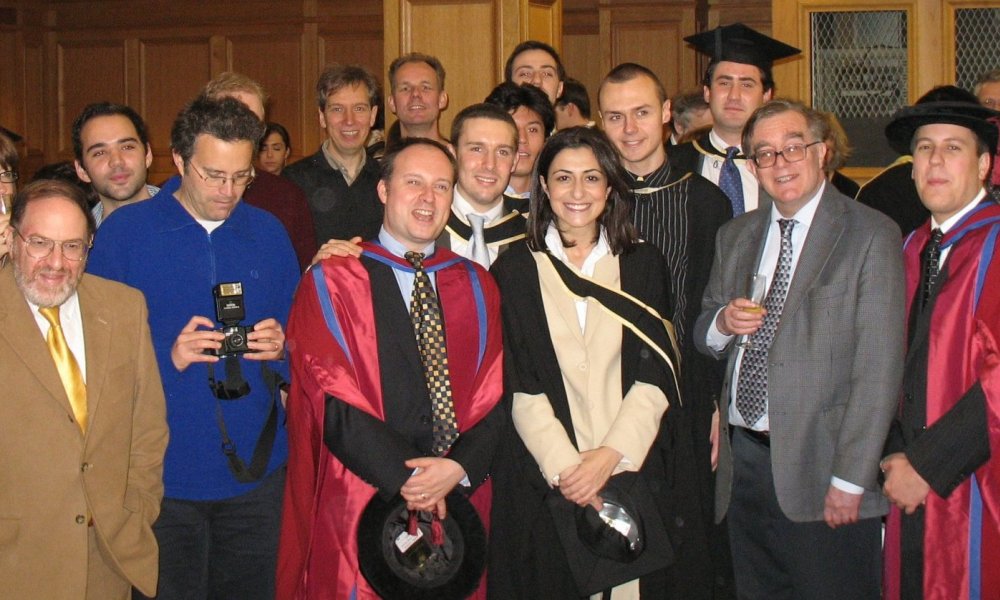
The subjects chosen for the new MSc programme reflected the changing face of mathematics globally. But in the UK old habits were dying hard. The traditional divide between Pure and Applied was ingrained in the UK community: the Pure mathematicians had a strong attachment to the intellectual rigour of their work, and the Applied mathematicians tended to focus on a few traditional topics, such as hydrodynamics. Fortunately LSE was able to recruit lecturers from a broader base, and consequently we could offer MSc courses in subjects such as Algorithms, Discrete Mathematics, Game Theory, Mathematical Finance, Information Theory, and Cryptography.
In 2005 Martin Anthony was promoted to a chair, and was rewarded by being made convener for the following session. A further opportunity for growth was provided by the retirement of Norman Biggs in the summer of 2006, which allowed the appointment of two additional lecturers. The retirement was another convenient fiction, but fortunately the replacements, Jozef Skokan and Tugkan Batu, were not.
For several years there had been much discussion in LSE about the place of Financial Mathematics. Eventually it was agreed that Mathematics should recruit a Professor and two Lecturers to form the basis for teaching an MSc in Financial Mathematics. Mihail Zervos joined the Department at the start of the 2006-07 session, and was followed by Pavel Gapeev in 2007 and Arne Lokka in 2008.
A significant event in May 2007 was a one-day Colloquium in Combinatorics, a discipline which, despite its Pure roots, was also important in the Applied field. A similar colloquium was held at another London college, Queen Mary, on the previous day, and this arrangement proved to be a success. The two linked colloquia have since become an annual event, with lectures by leading experts in the field, and good audiences, including many young researchers.
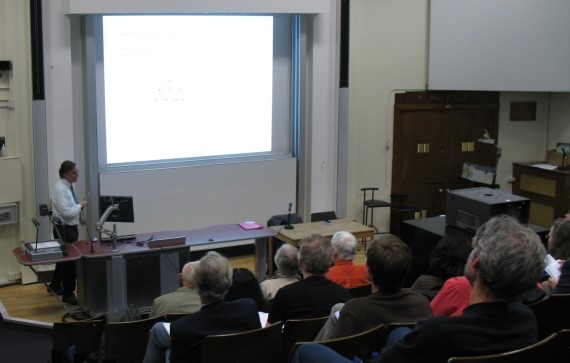
By the start of the 2007/08 session, the Department of Mathematics had achieved a critical mass, and was beginning to take shape – at least from an internal point of view. Bernhard von Stengel and Jan van den Heuvel had been promoted to chairs, and Adam Ostaszewski was a Reader, soon to be followed by Amol Sasane and Malwina Luczak. Another significant development was the appointment of Olivier Gossner to a chair in Game Theory. An external view was soon available, as there was another Research Assessment Exercise in 2008. Now there was agreement that the Department should be entered as a whole, and the outcome was that 45% of the work submitted was assessed as “world-leading” or “internationally excellent”, and almost all the rest was “internationally recognised”. A very comforting feature was that our position in the inevitable league tables was above that of several UK mathematics departments with a much longer history than ours.
The teaching for the MSc in Financial Mathematics began in September 2008, having attracted a large number of excellent applicants. At least six members of the Department were involved in this programme, including Nick Bingham, who had been appointed to a Visiting Professorship. Overall, the extent of the Department’s teaching had grown dramatically. The numbers registered for the various degrees in 2008/09 academic year were:
- BSc Mathematics and Economics: first year 107; second year 82; third year 66.
- MSc Applicable Mathematics: 31.
- MSc Financial Mathematics: 27.
The service teaching was also thriving. In 2009/10 there were 619 students taking the MA100: Mathematical Methods course, 254 taking MA107: Quantitative Methods, 240 taking MA212: Further Mathematical Methods, and 174 taking MA103: Introduction to Abstract Mathematics.
The next step was the introduction of a BSc degree in Mathematics with Economics, which would include 75% Mathematics, rather than the 50% in the Mathematics and Economics degree. The programme had been under discussion since 2006, and was finally approved in 2009. It allowed for a further broadening of the mathematical curriculum, and the appointment of new staff: Albina Danilova joined in July 2009, and Konrad Swanepoel in September 2009.
At the start of the 2010/11 session the Department was in good shape. There were encouraging signs of a closer relationship with the Operational Research group, currently located in the Department of Management, but destined to join Mathematics in 2015. The Department was ready to face the problems that beset all universities in the rapidly changing world: some of the indicators favoured by government ministers, such as research grants and “impact” required attention, and the number of research students was too low. Nevertheless, there were grounds for cautious optimism.
This post was originally published on the Maths at LSE blog.
Please read our comments policy before commenting



